Difference between revisions of "Dichanthelium commutatum subsp. equilaterale"
Treatment appears in FNA Volume 25. Treatment on page 414.
imported>Volume Importer |
imported>Volume Importer |
||
| (One intermediate revision by the same user not shown) | |||
| Line 36: | Line 36: | ||
|publication year= | |publication year= | ||
|special status= | |special status= | ||
| − | |source xml=https:// | + | |source xml=https://bitbucket.org/aafc-mbb/fna-data-curation/src/200273ad09963decb8fc72550212de541d86569d/coarse_grained_fna_xml/V25/V25_1141.xml |
|subfamily=Poaceae subfam. Panicoideae | |subfamily=Poaceae subfam. Panicoideae | ||
|tribe=Poaceae tribe Paniceae | |tribe=Poaceae tribe Paniceae | ||
Latest revision as of 18:55, 11 May 2021
Plants from loose caudices. Culms stiffly erect, glabrous. Basal blades large, usually 8-14 cm long, 7-22 mm wide. Cauline blades 5-14 mm wide, about 10 times longer than wide, linear, thin, firm, spreading. Spikelets 3-3.2 mm; lower glumes 1.6-1.8 mm, about 1/2 as long as the spikelets.
Discussion
Dichanthelium commutatum subsp. equilaterale grows in sandy pine and oak woodlands. Its range extends to southeastern Mexico and Nicaragua.
Selected References
None.
Lower Taxa
None.
... more about "Dichanthelium commutatum subsp. equilaterale"
